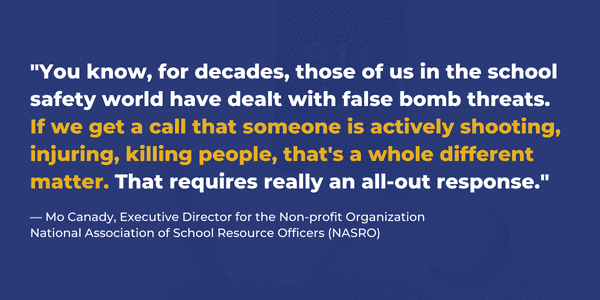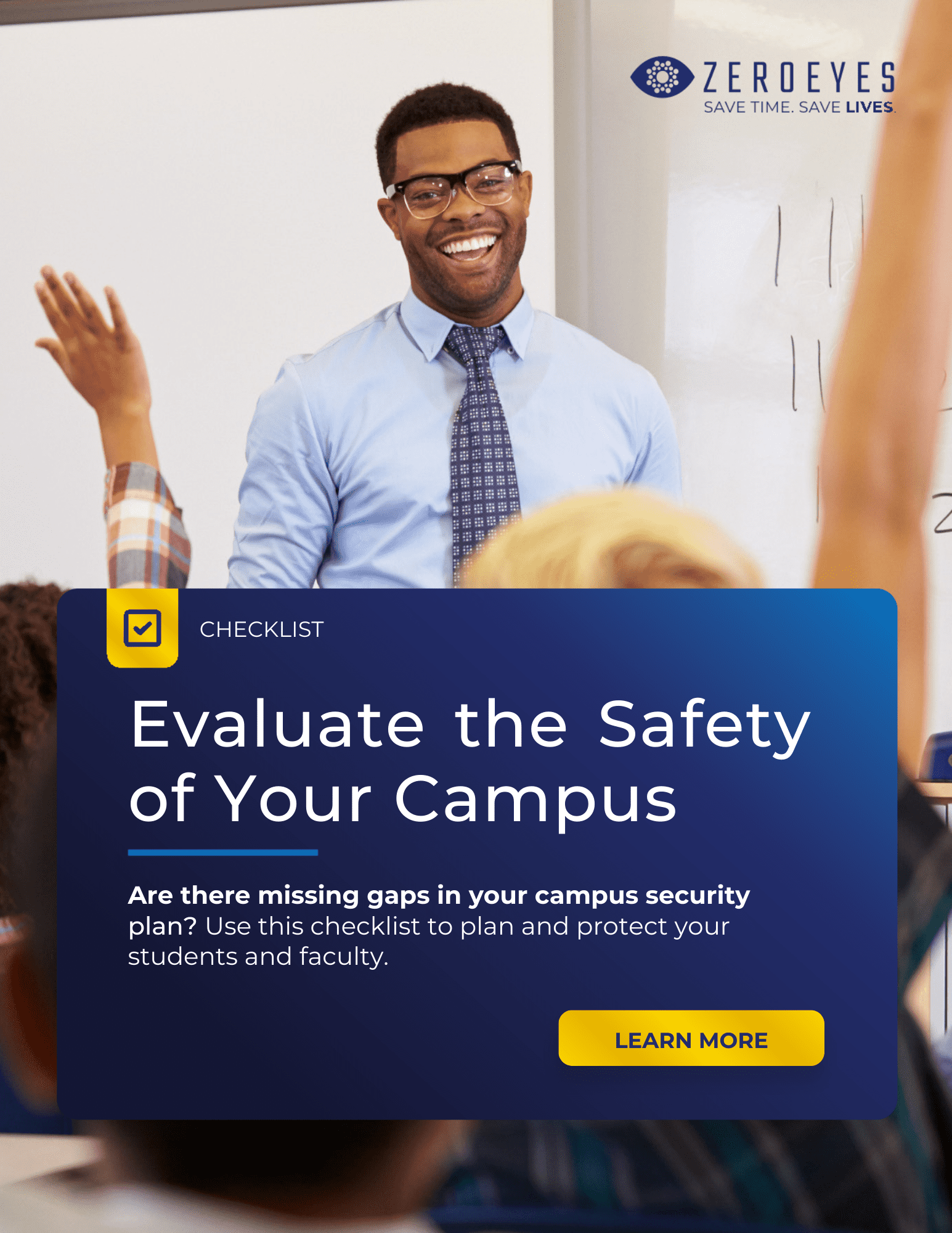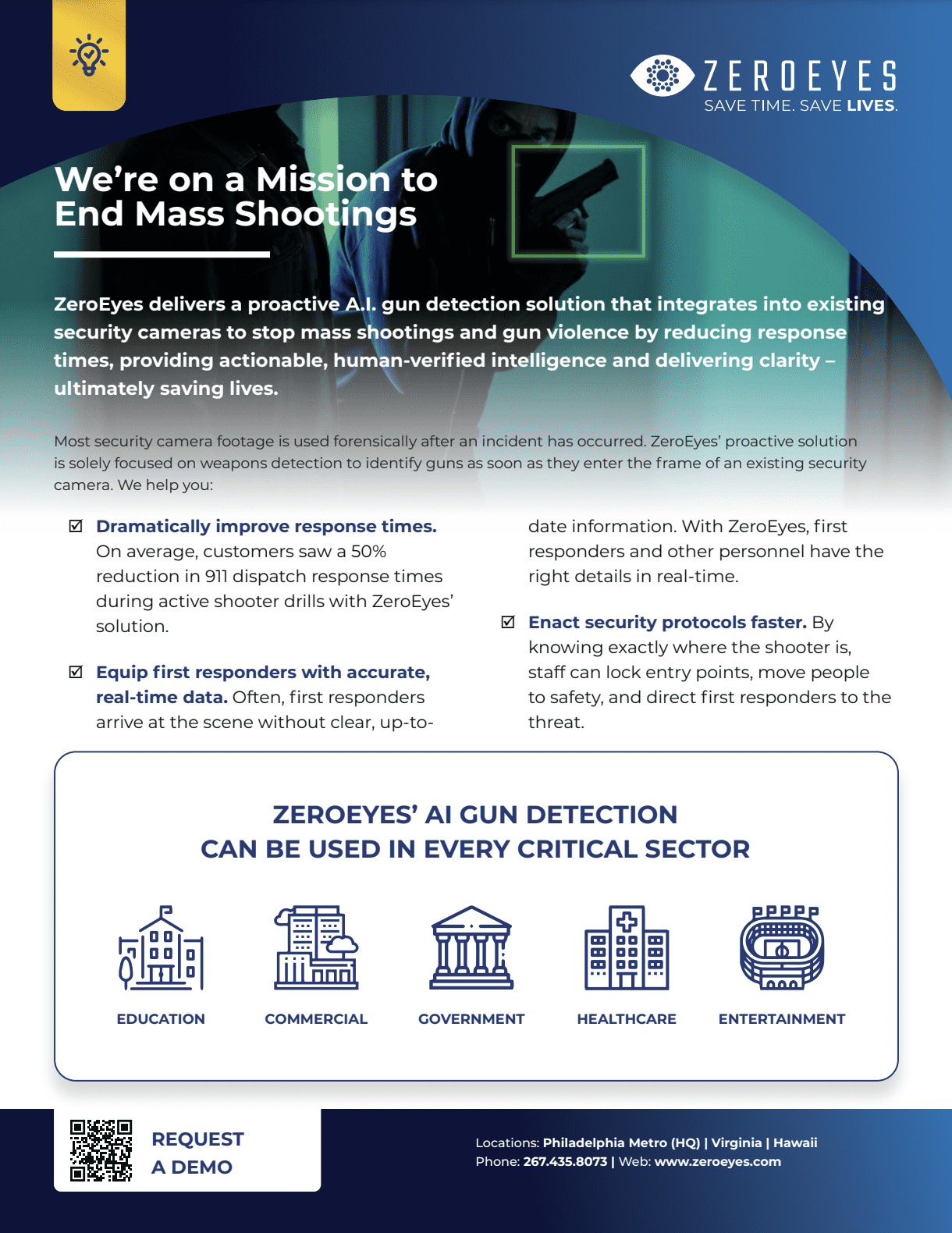When authorities and law enforcement are informed of the threat of a school shooting, an all-out response is required. Unlike bomb threats, which can be handled in a fairly calm evacuation, the threat of an active shooter causes a significantly higher degree of chaos, confusion, and fear.

Between dangerous social media challenges, like the “National Shoot Up Your School Day” TikTok challenge that encouraged students to make threats of violence against their school, the rise in school shooting incidents, and the recent surge in fake school shooting threats, safety concerns are at an all-time high.
Before we dive into what we can do to solve the problem, let’s first dissect why we’re seeing a surge in fake school shooting threats, the consequences of these hoax calls, and the current legal repercussions of those who try to pull a school shooting hoax.
What Is “Swatting?”
These fake shooting threats are known as “swatting,” which is when a person makes a hoax call to cause a large police or SWAT team response.
An Example of a Swatting Prank Gone Terribly Wrong
Swatting isn’t new. Years ago, this trend surfaced among the gamer community, eventually leading to the tragic death of an innocent man in 2017.
That hoax call was made by Tyler Barris, who reported a fake hostage situation after getting into an argument with another gamer while playing “Call of Duty.” Bariss sent police to an address he thought belonged to the other gamer. In reality, the address belonged to an innocent man completely unconnected to the argument. When officers arrived, they believed that this innocent man was holding family members hostage, and he was fatally shot. Bariss was sentenced to 20 years in prison in 2019.
What is disturbing about this recent trend of false school shooting threats is that in many cases, the caller’s identity is untraceable. Reports from NPR, Wired, and other news sources have traced many recent swatting calls to TextNow, an online platform that allows users around the world to make anonymous calls using U.S. numbers. With the expanse of free and low-cost voice over internet protocol (VoIP) platforms like TextNow, tracking down callers of fake school shooting threats is incredibly challenging.
While a prison sentence cannot make up for the tragic outcome of unnecessary loss of life, this heinous trend may only continue to grow if people are not held accountable for their actions.
Why Is There a Rise In Shooting Threats at Schools?
Why would anyone want to make a fake school shooting threat? It’s hard to pin down what’s fueling this surge of swatting calls, but there are a few theories out there.
Students and Disgruntled Pranksters
In some cases, a school shooting threat could be made by a misguided student who is trying to disrupt school to get out of class or skip a test. With the rise in social media challenges like the infamous “Shoot Up Your School Day” and “Devious Licks,” which encouraged students to steal and destroy as much as they can in their school’s bathrooms without getting caught, threats of violence are unfortunately becoming more normalized.
- Intentional False Threats: In September 2022, there were at least two cases where teens in Florida and Michigan were charged with making school shooting threats. Depending on the case, consequences can include suspension or expulsion, and even criminal prosecution and serious fines.
- Unintentional False Threats: Sometimes, the cause of a school shooting threat is more innocent. For example, rumors may spread among students until a good-willed student speaks out and alerts authorities of this potential danger.
However, with the high volume of swatting calls we’ve seen made in nearly 30 U.S. states, it’s very unlikely that misguided students are behind what we’re seeing today.
Domestic Bad Actors
Some people theorize that dark online communities may be targeting schools to cause fear and havoc in communities, which is a probable theory. In the past, we’ve seen these types of hoaxes originate within niche online communities.
Domestic bad actors may choose to target communities that are already on edge, such as residents of Texas who are still healing from the Uvalde tragedy.
Overseas Terrorism and Warfare
However, according to expert researchers, the volume of school swatting calls within such a short time period is unlike anything we’ve ever experienced. More and more, we’re seeing analysts and local police agencies discuss the possibility of these calls coming from overseas as a form of “warfare” or acts of terrorism.
The FBI is performing investigations and has not yet commented about the suspicion of calls coming in from overseas. However, a few local agencies have spoken about suspicion of the calls from Africa or Ethiopia.
NPR National Security Correspondents were able to obtain detailed records for some of these fake swatting calls and found a VoIP account tied to IP addresses in Ethiopia. They analyzed call logs and found patterns that suggest how these mass hoax threat campaigns may be planned and executed, with a bulk list of targeted schools and specific focuses on schools, law enforcement agencies, fire departments, and emergency dispatchers.
In this audio report provided by NPR, you can listen to three separate fake calls made in Virginia, Minnesota, and Ohio—all with a similar script, poor phone connection, and a heavy accent from a grown man. Data like this supports the idea that these false school shooting threats are part of mass hoax campaigns.

How Effective Is Your School Security Strategy?
Download our school safety checklist to assess any potential vulnerabilities or missing gaps in your school’s security strategy.
DOWNLOAD NOW
What Are the Dangers of School Shooting Threats Today?
Fake school shooting threats aren’t just a matter of inconvenience. They have serious outcomes that mirror the same negative effects of a real active shooter incident.
First, there’s the fear and chaos experienced among students, faculty and staff, parents, and the general community at large. Children call or text their parents about the active shooter threat, thinking this may be the last time they speak to them. Parents rush to school and are told to sit and wait out one of their worst nightmares.
During a recent school shooting hoax at Jefferson High School in San Antonio, Texas, a father injured himself trying to break a window at his child’s school that went on lockdown. Real or fake, the fear and chaos people experience are the same.
| Outcome | Active Shooter Hoax | Real Active Shooter Incident |
| Fear and Chaos | ✓ | ✓ |
| Disruption | ✓ | ✓ |
| Resources + Tax Dollars | ✓ | ✓ |
| Post-Event Trauma | ✓ | ✓ |
| Casualties | Increased risk of injury or even death due to police mistakenly shooting innocent person(s) | Loss of Life and/or serious injury |
Additionally, it’s not uncommon for students to experience post-event trauma after a fake school shooting threat. After all, they experienced very real, distressing emotions until they were safely back home. A school shooting hoax is still a life-changing event that shifts the way they view and experience the world, and can have lasting effects on mental health.
From an organizational perspective, resources and tax dollars are wasted due to the disruption. Fake threats like these take away from matters law enforcement should be spending time on to keep their communities safe.
Finally, the most devastating potential outcome of a fake active shooter threat is unnecessary loss of life. During an active shooter threat, police have to come in strong, heavy, and armed. They need to act quickly because lives are at stake. At the same time, this raises the level of hazard for everyone that is involved: the students, school staff, parents, and even police officers themselves. We’ve already witnessed the tragedy in 2017 when an innocent person was mistakenly fatally shot due to a swatting call, and the potential of seeing a similar tragic outcome repeated in a school setting is a tremendous concern.
With all of this being said, it’s never been more clear that across the board, school districts are in dire need of making improvements to their education security systems to protect their students and staff from both active shooter incidents and fake school shooting threats.
Are There Legal Repercussions for Calling In a Fake School Shooting Threat?
Yes. Issuing a false threat is a federal crime. This doesn’t just include phone calls—this also includes posts on social media, text messages, and emails. Those who post or send these threats can receive up to five years in federal prison, or they can face state or local charges.
Certain U.S. states have enacted stricter laws and penalties for fake school shooting threats. For example, false reporting in Florida is a second-degree felony that is punishable by up to 15 years in prison and a $10,000 fine.
With the surge in school swatting calls, state leaders may be looking towards creating harsher penalties for fake school shooting threats.
What Can We Do to Keep Schools Safer From These Threats?
No matter what, every school shooting threat needs to be treated with the highest degree of urgency. Even if a call seems suspicious or like it may be a hoax, potential lives are at stake and law enforcement needs to act quickly.
In response to this, districts may begin beefing up their school security systems with hardening measures like metal detectors. Or, they may begin hiring more security resource officers (SROs) to keep an eye on suspicious activity and respond quickly in the event of an active shooter threat. While SROs are a necessary layer of security, simply hiring more doesn’t help solve the problem.
The root cause of delayed active shooter response among SROs and law enforcement is a lack of situational awareness. If an SRO doesn’t have the critical information they need, such as the perpetrator’s location or what they look like, then their response is delayed.
If we look back at the Robb Elementary School shooting in Uvalde, Texas, 376 law enforcement officers responded but failed to take action because they did not have situational awareness. More SROs and officers do not equate to improved active shooter response. Instead, they need to be equipped with situational awareness to do their job effectively to save time and save lives.

Discover How A.I. Gun Detection Provides Enhanced Situational Awareness for SROs
Download our overview brochure to see how ZeroEyes’ A.I. helps keep schools safer by providing security, administration, and first responders with situational awareness.
DOWNLOAD NOW
Schools Need Security Technology That Provides Situational Awareness
While a solution to prevent fake school shooting threats from happening doesn’t exist, providing school administration, on-site security, and law enforcement with advanced situational awareness can solve two important challenges.
Solution #1: Helps Avoid Unintentional False Alarms
Sometimes school shooting threats happen because of rumors. A student brings in a toy gun, shows it off, and false rumors spread fast. This scenario could end badly, with unnecessary calls made to law enforcement—increasing the level of hazard for innocent students.
With ZeroEyes’ A.I., a gun detection alert would route to our operations center once a potential gun becomes visible on a school security camera. Our military-trained analysts would be able to verify that it’s a fake gun and appropriately notify school administration.
Here’s a real-life example of how we helped one of our education clients avoid a false alarm that could have easily gotten out of control: two male students were pretending to shoot each other with an app on their phones. The app emitted realistic gunshot sounds and their phones looked like small handguns from afar. Students quickly started posting this on social media and rumors began to spread.
Luckily, ZeroEyes’ A.I. detected this potential gun and our analysts were able to verify that no real weapons were involved. Our analysts notified school administration of this event and let them know that there was no need to call law enforcement. Without real-time intelligence from ZeroEyes, this scenario could have escalated to the point where students or school staff made 911 calls, causing unnecessary panic and increased hazard for all involved.
Solution #2: Improves Response Times and Mitigates Risks
Should a bad actor bring a gun on campus, ZeroEyes’ A.I. can provide law enforcement with the intel they need to act quickly—sometimes even before shots are fired.
In an active shooter training event, Rancocas Valley Regional High School was able to improve officer response time by nearly two-thirds. The response time for officers to reach the “gunman” without implementing ZeroEyes was 3 minutes and 13 seconds. With ZeroEyes, officers responded and made first contact in 1 minute and 15 seconds.

Download this guide to discover how A.I. gun detection technology can keep schools safer from gun-related violence, or request a demo here.

